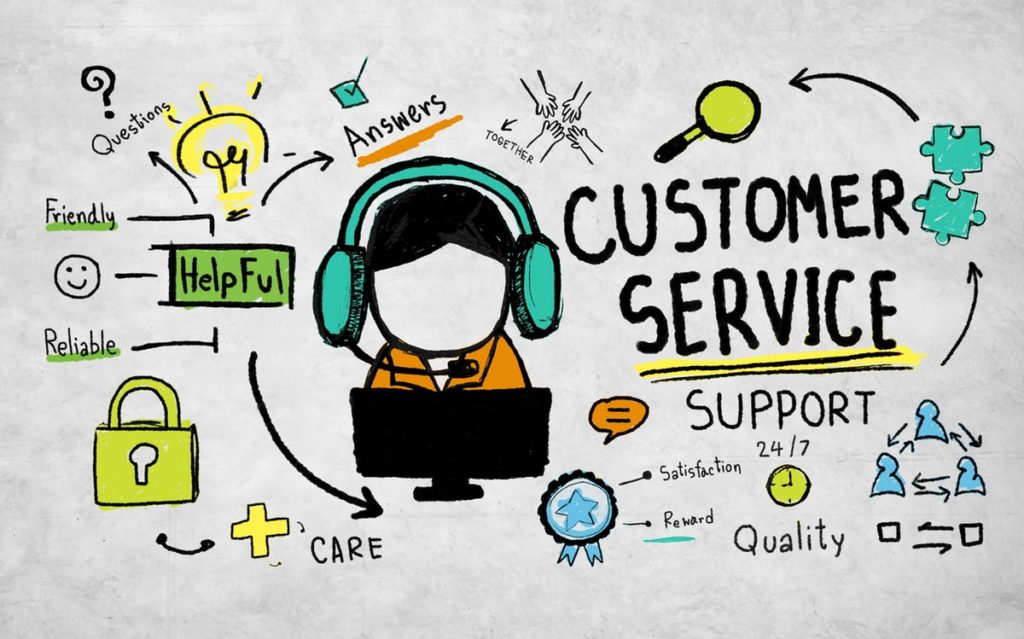Marketers who are responsible for the e-commerce promotion struggle with new ideas. The sales team does their best to research competitors, products and services, but they often fail. Agencies prepare strategies that may work… or may not. A lot of factors are likely to be taken into consideration while running an e-commerce business, but many forget about what really matters: customer service. And, while an unintuitive user interface and technical issues can definitely affect your sales outreach in a negative way, the thing that can be extremely off-putting for your potential clients is customer service.

Numbers speak for themselves
Data-driven or customer-centric?
According to Microsoft data (The Microsoft 2017 State of Global Customer Service), 54% of consumers claim that they have higher expectations for customer service than a year ago. 96% of respondents regard customer service as a factor that impacts their choice of brand, as well as loyalty between a client and a product. 72% of respondents expect brands to have full customer information: their history of shopping, data and level of overall satisfaction.
Long story short: customer service matters like never before, so brands who see no potential in it may struggle in the long-term.
It’s not (only) about the product
The main goal of customer service, and not just in the world of e-commerce, seems to be easy-peasy: customer support. However, customer service that is based purely online faces a few challenges, including a lack of physical interaction with clients and, therefore, difficulty in building relations.
In brick-and-mortar stores, a huge role is played by the offer, assortment, but also the team, the decor and the atmosphere in the place. Online shops are where customer experience, user interface and content matter the most. It is becoming increasingly hard to stand out with an amazing offer – but you can stand out from the competition with amazing customer service that will take you places (and make your clients come back more eagerly and often). Building trust takes time.
A client who is satisfied with customer service is likely to come back. A client who is disappointed with customer service will not only turn their back on your shop but will also spread the word about it to their peers, making them uninterested in your shop’s offer too – even if it may be a competitive one.
Helpscout data proves this to be true: while only 4% of customers actually write about disappointments, an impressive 86% of customers will never come back to a shop after an unpleasant experience, without any feedback.
That’s why recommendations and social proof are important factors to take into consideration by retailers – but sometimes it takes a while to get satisfying feedback. You can make it quicker with personalized messages or discounts offered in return for a recommendation.
You might forget products, you won’t forget customer service
In the past, shopping online was nothing but just trying to buy a particular product already seen offline. Simple as that. Today, things are a bit more complicated, as online shopping is often caused by a “shopping impulse” – for example, inspiration seen on social media or ads displayed on a website we were on. Shopping is the answer to some needs and problems. Expectations have changed: while free delivery or return was a “wow” factor a few years ago, today such a service is actually required and a lack thereof may lead to losing a customer.
Customer service is in charge of even more processes than in the past: thanks to right moves, quick responses and flexible availability they can meet the requirements of even the most impatient clients.
One step too many and your shop is replaced by the next on the list.

How to provide the best possible customer experience?
There are a few ways you can improve your customer service.
Six essential questions
- do you offer a variety of shopping options and payment methods? Any lack here can cost you unsatisfied customers who would turn to your competitors. It doesn’t sound too fortunate, does it?
- is the shop secure enough? An SSL certificate is a must, but there are many other bits and bobs you should keep an eye on.
- does your website load quickly? Sometimes one plug-in can clog your website for good.
- can each and every one of your clients count on spotless customer service (a help center, web chat, vanity phone number or social media discussion?)
- do you use up-selling and cross-selling actively?
- do you communicate delivery and returns policies in a transparent way? Do you offer various methods of delivery?
Good practices & tools
Even with the best customer service crew in the world, you are very likely to encounter some obstacles, problems and complaints. How to deal with them and prevent them from happening?
Don’t annoy your client
Whenever you need to deal with a client, you must have a complex database of information about them and their interactions with your business. It’s not only to save your time and efforts – it is to increase your client’s satisfaction, since they won’t have to repeat the same things over and over again, especially in a situation when things may be getting out of control quickly. You can track it manually up to some point – but then you should get a bit of help from external tools. One of them is CloudTalk.io – a cloud-based call center software allowing you to see the history of orders, interactions and notes in a real-time customer information card. This kind of automation actually supports personalization, as agents can focus on a customized approach instead of spending time on processes. Also, it can be integrated with external e-commerce systems and social platforms, giving you a full overview of the information you need and which the client requires you to know, without their interference. You need a well-equipped call center to offer excellent customer service.
Be where your clients are
Your clients may prefer one channel of communication over another, and there is nothing wrong with that. Probably it will give you more work to do, but you can’t ignore the signs given by your clients and their activity on particular sites or platforms. If a certain client raised an issue on Twitter then they want to have it sorted on Twitter – nowhere else. If you are going to redirect them between platforms, you may lose credibility and stand out as providing a worse customer experience than your competitors who are able to handle issues whenever and wherever they were reported.

Let your clients find answers instantly
Chances are your clients won’t press the “send” button if they find an answer to their question before. Many companies see zero to little potential in covering their sites in content that could actually come in handy not once and not twice for their customers. The main excuses are lack of money or time to build one, while in reality, it’s not as scary as it seems. UseResponse provides with opportunities to build a help center, customer feedback platform or knowledge base for self-service support. It’s always a good idea to publish native content on your site, too – clients may come across it while seeking solutions. Your customer service team will thank you for this – as long as this kind of tool won’t replace customer support completely, it will help minimize requests, tickets and complaints.
Care about internal communication
Implementing a well-organized internal communication system is not a walk in the park, but it is necessary to maintain and develop a customer service team (especially if they are directly or indirectly responsible for sales and lead nurturing). Here is where tools come to save the day, too. First of all, you need a secure and reliable solution to manage files, exchange messages or delegate tasks, and this is where you can find Stackfield really helpful. Secondly, CRM is not an option, it is a must. You need to find the best CRM software for your team. Livespace helps to increase the quality of collected data, support the internal exchange of knowledge and makes sales great again.
Key takeaways
- amazing customer service is not a luxury – it is a standard required by clients
- focusing on customer service before or after transactions also increases the chances of client retention
- building relations with each and every client is not a single activity but a process that takes time and constant analysis
In the past, it was all about the price tag, but today emotions and impressions play a major role. Clients need more than a good price to push the “buy now” button.
Successful customer service provides nothing but benefits: higher sales, higher client retention, a higher level of loyalty and trust, better recognition and brand awareness, and fewer returns or complaints.



